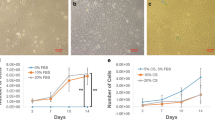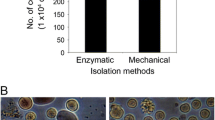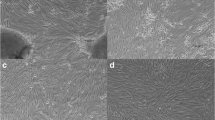Abstract
There are only few primary endothelial cell cultures developed from fishes to date, but in this work the development of an endothelial cell line from Channa striatus is described. The vascular explants were plated into fibronectin (5 µg ml−1) and anti-CD31 antibody (100 ng ml−1)-coated flask; after 60 h incubation explants were removed from the flask. The flask contained only endothelial and blood cells. Blood cells were cleared out after subsequent passages. The culture medium used was Leibovitz’s L-15 supplemented with 20 % serum and antibiotics. The cultures were incubated at 28 °C in a normal atmosphere incubator. The plating efficiency was high (53.72 %). The endothelial cells were cryopreserved at different passage levels and revived successfully with 75–85 % survival. Polymerase chain reaction amplification of mitochondrial 16S rRNA using primer specific to C. striatus confirmed the origin of C. striatus cardiovascular endothelial (CSCVE) cell line from C. striatus. This cell line was further characterized for chromosome number, transfection, mycoplasma, cell cycle distribution, mitochondrial staining, and phagocytic activity. Cells were analyzed according to morphological appearance and expression of specific endothelial markers by fluorescent staining (von Willebrand Factor, anti-platelet endothelial cell adhesion molecule-1, and anti-Endoglin). The formation of tubules in the Matrigel and endothelial co-cultured with fibroblast like cells was observed. The cytotoxicity of ciprofloxacin on the CSCVE cell line was determined by MTT, AB, and R-123 cytotoxicity end points. Susceptibility of CSCVE cell line to nodavirus was confirmed by cytopathic effect and reverse transcriptase-polymerase chain reaction.













Similar content being viewed by others
References
Wolf, K., & Quimby, M. C. (1962). Established eurythermic line of fish cells in vitro. Science, 135, 1065–1066.
Lakra, W. S., Raja Swaminathan, T., & Joy, K. P. (2011). Development, characterization, conservation and storage of fish cell lines: A review. Fish Physiology and Biochemistry, 37, 1–20.
Babich, H., & Borenfreund, E. (1991). Cytotoxicity and genotoxicity assays with cultured fish cells: A review. Toxicology in Vitro, 5, 91–100.
Segner, H. (1998). Fish cell lines as a tool in aquatic toxicology. Fish Ecotoxicology EXS, 86, 1–38.
Taju, G., Abdul Majeed, S., Nambi, K. S. N., Sarath Babu, V., Vimal, S., Kamatchiammal, S., et al. (2012). Comparison of in vitro and in vivo acute toxicity assays in Etroplus suratensis (Bloch, 1790) and its three cell lines in relation to tannery effluent. Chemosphere, 87, 55–61.
Taju, G., Abdul Majeed, S., Nambi, K. S. N., & Sahul Hameed, A. S. (2013). Development and characterization of cell line from the gill tissue of Catla catla (Hamilton, 1822) for toxicological studies. Chemosphere, 90, 2172–2180.
Abdul Majeed, S., Nambi, K. S. N., Taju, G., Sundar Raj, N., Madan, N., & Sahul Hameed, A. S. (2013). Establishment and characterization of permanent cell line from gill tissue of Labeo rohita (Hamilton) and its application in gene expression and toxicology. Cell Biology and Toxicology, 29, 59–73.
Wolf, K. (1988). Fish viruses and fish viral diseases. New York: Cornell University Press.
Parameswaran, V., Ishaq Ahmed, V. P., Ravi, S., Bhonde, R. R., & Sahul Hameed, A. S. (2007). Development and characterization of two new cell lines from milkfish (Chanos chanos) and grouper (Epinephelus coioides) for virus isolation. Marine Biotechnology, 9, 281–291.
Sarath Babu, V., Chandra, V., Nambi, K. S. N., Majeed, S. A., Taju, G., Patole, M. S., et al. (2012). Development and characterization of novel cell lines from Etroplus suratensis and their applications in virology, toxicology and gene expression. Journal of Fish Biology, 80, 312–334.
Sarath Babu, V., Abdul Majeed, S., Nambi, K. S. N., Taju, G., Madan, N., Sundar Raj, N., et al. (2013). Comparison on betanodavirus replication efficiency in ten Indian fish cell lines. Archives of Virology, 158(6), 1367–1375.
Abdul Majeed, S., Nambi, K. S. N., Taju, G., & Sahul Hameed, A. S. (2013). Development, characterization and application of a new fibroblastic-like cell line from kidney of a freshwater air breathing fish Channa striatus (Bloch, 1793). Acta Tropica, 127, 25–32.
Bols, N. C., Brubacher, J. L., Ganassin, R. C., & Lee, L. E. J. (2001). Ecotoxicology and innate immunity in fish. Developmental and Comparative Immunology, 25, 853–873.
Clem, L. W., Bly, J. E., Wilson, M., Chinchar, V. G., Stuge, T., Barker, K., et al. (1996). Fish immunology: The utility of immortalized lymphoid cells—a mini review. Veterinary Immunology and Immunopathology, 54, 137–144.
Castano, A., Bols, N., Braunbeck, T., Dierickx, P., Halder, M., Isomaa, B., et al. (2003). The use of fish cells in ecotoxicology. Alternatives to Lab Animals, 31(3), 317–351.
Fent, K. (2001). Fish cell lines as versatile tools in ecotoxicology: Assessment of cytotoxicity, cytochrome P4501A induction potential and estrogenic activity of chemicals and environmental samples. Toxicology in Vitro, 15, 477–488.
Schirmer, K. (2006). Proposal to improve vertebrate cell cultures to establish them as substitutes for the regulatory testing of chemicals and effluents using fish. Toxicology, 224, 163–183.
Hightower, L. H., & Renfro, J. L. (1988). Recent applications of fish cell culture to biomedical research. Journal of Experimental Zoology, 248, 290–302.
Bols, N. C., & Lee, L. E. J. (1991). Technology and uses of cell culture from tissues and organs of bony fish. Cytotechnology, 6, 163–187.
Villena, A. J. (2003). Applications and needs of fish and shellfish cell culture for disease control in aquaculture. Reviews in Fish Biology and Fisheries, 13, 111–140.
Bols, N. C. (1991). Biotechnology and aquaculture: the role of cell cultures. Biotechnology Advances, 9, 31–49.
Ryan, L. A., Seymour, C. B., O’Neill-Mehlenbacher, A., & Mothersill, C. E. (2008). Radiation-induced adaptive response in fish cell lines. Journal of Environmental Radioactivity, 99, 739–747.
Blaxhall, P. C. (1983). Chromosome karyotyping of fish using conventional and G-banding methods. Journal of Fish Biology, 22, 417–424.
Santer, R. M. (1985). Morphology and innervation of the fish heart (pp. 5–45). Berlin Heidelberg New York: Springer.
Koren, C. W. R., Sveinbjornsson, B., & Smedsrod, B. (1997). Isolation and culture of endocardial endothelial cells from Atlantic salmon (Salmo salar) and Atlantic cod (Gadus morhua). Cell Tissue Research, 290, 89–99.
Smedsrod, B., Olsen, R., & Sveinbjornsson, B. (1995). Circulating collagen is catabolized by endocytosis mainly by endothelial cells of endocardium in cod (Gadus morhua). Cell Tissue Research, 280, 39–48.
Pereira, C. A., Steffan, A. M., & Kirn, A. (1984). Kupffer and endothelial liver cell damage renders A/J mice susceptible to mouse hepatitis virus type 3. Virus Research, 1, 557–563.
Scoazec, J. Y., & Feldman, G. (1990). Both macrophages and endothelial cells of the human hepatic sinusoid express the CD4 molecule, a receptor for the human immunodeficiency virus. Hepatology, 12, 505–510.
Steffan, A. M., Gendrault, J. L., Schweitzer, C., Schmitt, M. P., Royer, C., Aubertin, A. M., et al. (1991). Multiplication of human immunodeficiency virus type I (HIV-1) in cultured human endothelial liver cells. In E. Wisse, D. L. Knook, & R. S. McCuskey (Eds.), Cells of the hepatic sinusoid (Vol. 3, pp. 417–422). Leiden: The Kupffer Cell Foundation.
Steffan, A. M., Lafon, M. E., Gendrault, J. L., Schweitzer, C., Royer, C., Jaeck, D., et al. (1992). Primary cultures of endothelial cells from the human liver sinusoid are permissive for human immunodeficiency virus type 1. Proceedings of the National Academy of Sciences of the United States of America, 89, 1582–1586.
Hovland, T., Nylund, A., Watanabe, K., & Endresen, C. (1994). Observation of infectious salmon anaemia virus in Atlantic salmon, Salmo salar L. Journal of Fish Disease, 17, 291–296.
Nylund, A., Hovland, T., Watanabe, K., & Endresen, C. (1995). Prescence of infectious salmon anaemia virus (ISAV) in tissues of Atlantic salmon, Salmo salar L., collected during three separate outbreaks of the disease. Journal of Fish Disease, 18, 135–145.
Galley, H. F., & Webster, N. R. (2004). Physiology of the endothelium. British Journal of Anaesthesia, 93(1), 105–113.
Olson, K. R. (1994). Circulatory anatomy in bimodally breathing fish. American Zoologist, 34(2), 280–288.
Datta Munshi, J. S., & Singh, B. N. (1968). On the micro-circulatory system of the gills of certain freshwater teleostean fishes. Journal of Zoology London, 154, 365–376.
Daugherty, A., Herrington, D., Greenland, P., Roberts, H., & Taubert, K. A. (March 2005). American Heart Association addresses use of pain medications. Journal Report. www.americanheart.org.
Nave, B. T., Becker, M., Roenicke, V., & Henkel, T. (2002). Validation of targets and drug candidates in an engineered three-dimensional cardiac tissue model. Drug Discovery Today, 7, 419–425.
Garrick, R. A. (2000). Isolation and culture of capillary endothelial cells from the eel, Anguilla rostrata. Microvascular Research, 59, 377–385.
Matsuyama, T., & Iida, T. (2002). Tilapia mast cell lysates enhance neutrophil adhesion to cultured vascular endothelial cells. Fish and Shellfish Immunology, 13, 243–250.
Huang, Y. S., Huang, W. L., Lin, W. F., Chen, M. C., & Jeng, S. R. (2006). An endothelial-cell-enriched primary culture system to study vascular endothelial growth factor (VEGF A) expression in a teleost, the Japanese eel (Anguilla japonica). Comparative Biochemistry and Physiology Part A, 145, 33–46.
Freshney, R. I. (1994). Culture of animal cells: A manual of basic technique. New York: Wiley-Liss.
Chen, S. L., Sha, Z. X., & Ye, H. Q. (2003). Establishment of a pluripotent embryonic cell line from sea perch blastula embryo. Aquaculture, 218, 141–151.
Lo, C. F., Leu, J. H., Ho, C. H., Chen, C. H., Peng, S. E., Chen, Y. T., et al. (1996). Detection of baculovirus associated with white spot syndrome (WSSV) in penaeid shrimps using polymerase chain reaction. Diseases of Aquatic Organisms, 25, 133–141.
Sahul Hameed, A. S., Parameswaran, V., Shukla, R., Singh, B., & Bhonde, R. R. (2006). Establishment and characterization of India’s first marine fish cell line from kidney of sea bass, Lates calcarifer. Aquaculture, 257, 92–103.
Rocha, A., Ruiz, S., & Coll, J. M. (2004). Improvement of transfection efficiency of epithelioma papulosum cyprinid carp cells by modification of cell cycle and use of an optimal promoter. Marine Biotechnology, 6, 401–410.
Bishop, E. T., Bell, G. T., Bloor, S., Broom, I. J., Hendry, N. F. K., & Wheatley, D. N. (1999). An in vitro model of angiogenesis: Basic features. Angiogenesis, 3, 335–344.
Mosmann, T. (1983). Rapid colorimetric assay for cellular growth and survival: Application to proliferation and cytotoxicity assays. Journal of Immunological Methods, 65, 55–63.
Johnson, L. V., Walsh, M. L., & Chen, L. B. (1980). Localization of mitochondria in living cells with rhodamine 123. Proceedings of the National Academy of Sciences of the United States of America (Cell Biology), 77(2), 990–994.
Dayeh, V. R., Bols, N. C., Schirmer, K., & Lee, L. E. J. (2003). The use of fish-derived cell lines for investigation of environmental contaminants. In E. Hodgson (ed.), Current protocols in toxicology (pp. 1–17). New York: Wiley.
Fan, T. J., Wang, L. Y., Geng, X. F., Cong, R. S., Li, M. Y., Yu, Q. T., et al. (2006). Studies of the propagation of turbot reddish body iridovirus in vitro. Journal of Ocean University of China, 36, 767–774.
Parameswaran, V., Rajesh Kumar, S., Ishaq Ahmed, V. P., & Sahul Hameed, A. S. (2008). A fish nodavirus associated with mass mortality in hatchery-reared Asian Sea bass, Lates calcarifer. Aquaculture, 275, 366–369.
Nishizawa, T., Mori, K., Nakai, T., Furusawa, I., & Muroga, K. (1994). Polymerase chain reaction (PCR) amplification of RNA of striped jack nervous necrosis virus (SJNNV). Diseases of Aquatic Organisms, 18, 103–107.
Matsuyama, T., Yamada, A., Kay, J., Kennethm, T., Yamada, K. M., Akiyama, S. K., et al. (1989). Activation of CD4 cells by fibronectin and anti-CD3 antibody a synergistic effect mediated by the VLA-5 fibronectin receptor complex. Journal of Experimental Medicine, 170, 1133–1148.
Chen, S. F., Fei, X., & Li, S. H. (1995). A new simple method for isolation of microvascular endothelial cells avoiding both chemical and mechanical injuries. Microvascular Research, 50, 119–128.
Loiola, R. A., Torres, T. C., Aburaya, C. M., Landgraf, M. A., Landgraf, R. G., Pesquero, J. B., et al. (2013). Generation and characterization of a spontaneously immortalized endothelial cell line from mice microcirculation. Experimental Cell Research, 319(8), 1102–1110.
Avella, M., Berhaut, J., & Payan, P. (1994). Primary culture of gill epithelial cells from the sea bass Dicentrarchus labrux. In Vitro Cellular and Developmental Biology—Animal, 30, 41–49.
Zhao, Z., Montgomery-Brock, D., Lee, C. S., & Lu, Y. (2003). Establishment, characterization and viral susceptibility of 3 new cell lines from snakehead, Channa striatus (Bloch). Methods in Cell Science, 25, 155–166.
Banerjee, S. K., Misra, K. K., Banerjee, S., & Ray-Chaudhuri, S. P. (1988). Chromosome numbers, genome sizes, cell volumes and evolution of snake-head fish (family Channidae). Journal of Fish Biology, 33(5), 781–789.
Ishaq Ahmed, V. P., Chandra, V., Sudhakaran, R., Rajesh Kumar, S., Sarathi, M., Sarath Babu, V., et al. (2009). Development and characterization of cell lines derived from rohu, Labeo rohita (Hamilton), and catla, Catla catla (Hamilton). Journal of Fish Disease, 32, 211–218.
Chen, T. R. (1977). In situ detection of mycoplasma contamination in cell cultures by fluorescent Hoechst 33258 stain. Experimental Cell Research, 104, 255–262.
Hessling, J. J., Miller, S., & Levy, L. (1980). A direct comparison of procedures for the detection of mycoplasma in tissue culture. Journal of Immunological Methods, 38, 315–324.
Freiberg, E. F., & Masover, G. K. (1990). Mycoplasma detection in cell culture by concomitant use of bisbenzamide and fluoresceinated antibody. In Vitro Cellular and Developmental Biology—Animal, 26, 585–588.
Mannucci, P. M. (1995). Platelet von Willebrand factor in inherited and acquired bleeding disorders. Proceedings of the National Academy of Sciences of the United States of America, 92, 2428–2432.
Sun, Q. H., Paddock, C., Visentin, G. P., Zukowski, M. M., Muller, W. A., & Newman, P. J. (1998). Cell surface glycosaminoglycans do not serve as ligands for PECAM-1: PECAM-1 is not a heparin-binding protein. Journal of Biological Chemistry, 273, 11483–11490.
Nakada, M. T., Amin, K., Christofidou-Solomidou, M., O’Brien, C. D., Sun, J., Gurubhagavatula, I., et al. (2000). Antibodies against the first Ig-like domain of human platelet endothelial cell adhesion molecule-1 (PECAM-1) that inhibit PECAM-1-dependent homophilic adhesion block in vivo neutrophil recruitment. Journal of Immunology, 164, 452–462.
Lebrin, F., Goumans, M. J., Jonker, L., Carvalho, R. L. C., Valdimarsdottir, G., Thorikay, M., et al. (2004). Endoglin promotes endothelial cell proliferation and TGF-b/ALK1 signal transduction. The EMBO Journal, 23, 4018–4028.
Wagner, D. D., Olmsted, J. B., & Marder, V. J. (1982). Immunolocalization of von Willebrand protein in Weibel–Palade bodies of human endothelial cells. Journal of Cell Biology, 95, 355–360.
Edgell, C. J., McDonald, C. C., & Graham, J. B. (1983). Permanent cell line expressing human factor VIII-related antigen established by hybridization. Proceedings of the National Academy of Sciences of the United States of America, 80, 3734–3737.
Bauer, J., Margolis, M., Schreiner, C., Edgell, C. J., Azizkhan, J., Lazarowski, E., et al. (1992). In vitro model of angiogenesis using a human endothelium-derived permanent cell line: Contributions of induced gene expression, G-proteins, and integrins. Journal of Cellular Physiology, 153, 437–449.
Edgell, C. J., Haizlip, J. E., Bagnell, C. R., Packenham, J. P., Harrison, P., Wilbourn, B., et al. (1990). Endothelium specific Weibel–Palade bodies in a continuous human cell line, EA.hy926. In Vitro Cellular and Developmental Biology—Animal, 26, 1167–1172.
Balconi, G., Spagnuolo, R., & Dejana, E. (2000). Development of endothelial cell lines from embryonic stem cells: A tool for studying genetically manipulated endothelial cells in vitro. Arteriosclerosis, Thrombosis, and Vascular Biology, 20, 1443–1451.
Donovan, D., Brown, N. J., Bishop, E. T., & Lewis, C. E. (2001). Comparison of three in vitro human angiogenesis assays with capillaries formed in vivo. Angiogenesis, 4, 113–121.
Gurbay, A., Gonthier, B., Barret, L., Favier, A., & Hıncal, F. (2007). Cytotoxic effect of ciprofloxacin in primary culture of rat astrocytes and protection by Vitamin E. Toxicology, 229(1–2), 54–61.
Kloskowski, T., Olkowsk, J., Nazlica, A., & Drewa, T. (2010). The influence of ciprofloxacin on hamster ovarian cancer cell line CHO AA8. Acta Poloniae Pharmaceutica—Drug Research, 67(4), 345–349.
Acknowledgments
S. Abdul Majeed is a recipient of INSPIRE Fellowship from the Department of Science and Technology, Government of India, New Delhi, India. The authors thank the management of C. Abdul Hakeem College, Melvisharam, India, for providing the facilities to carry out this work. This work was funded by the Department of Biotechnology, Government of India, New Delhi, India.
Conflict of interest
The authors declare that they have no conflict of interest.
Author information
Authors and Affiliations
Corresponding author
Rights and permissions
About this article
Cite this article
Abdul Majeed, S., Nambi, K.S.N., Taju, G. et al. Isolation, Propagation, Characterization, Cryopreservation, and Application of Novel Cardiovascular Endothelial Cell Line From Channa striatus (Bloch, 1793). Cell Biochem Biophys 71, 601–616 (2015). https://doi.org/10.1007/s12013-014-0240-x
Published:
Issue Date:
DOI: https://doi.org/10.1007/s12013-014-0240-x




